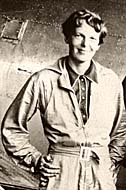Undersea search
for Earhart’s
plane set
An explorer believes the depths
would preserve any wreck
![]()

Amelia Earhart poses in front of her plane in Los Angeles in 1937 before her ill-fated attempt to fly around the world.
Ideal conditions, in other words, for preserving an airplane that might have crashed into the depths nearly 70 years ago, according to marine explorer David Jourdan, who hopes to answer one of aviation's greatest mysteries -- the fate of famed pilot Amelia Earhart.
Jourdan and his Maine-based company, Nauticos, plan to launch an expedition in the spring using sonar to sweep a 1,000-square-mile swath of ocean bottom west of tiny Howland Island in the Pacific Ocean.
It is the latest in a string of missions to learn what happened to Earhart when she, her navigator and their Lockheed Electra plane disappeared on a flight around the world.
"Things tend to last a time" in the deep ocean, said Jourdan. "Our expectation is the plane will be largely, if not completely, intact."
That is, if the plane is even in the ocean.
There are many theories about what befell Earhart and navigator Fred Noonan in 1937 as they made one of the final legs of their widely heralded flight.
Some have searched the sea, believing the plane ran out of gas. Others think she survived a crash landing but died on a deserted island. Another theory is that the Japanese captured and executed her. The conspiracy-minded claim that Earhart survived and lived out her life under an assumed name as a New Jersey housewife.

The Navy launched a weeks-long search of 250,000 square miles of ocean around Howland and a nearby chain of small islands. No trace was ever found of the plane.
This is Jourdan's second search of the area west of Howland; a 2002 mission was aborted because of technical problems. The same general area was searched in 1999 by another mission that found nothing conclusive, but Jourdan said his new expedition, costing about $1.5 million, will use better sonar technology and more accurate information on where the plane may have crashed.
The shortage of oxygen and the fairly still water means a metal airplane likely would not have completely corroded, he said. Any human remains would have long vanished, but Jourdan hopes to find clues, such as Earhart's jewelry in the pilot's seat.
"That would be eerie," he said.
If he finds it, Nauticos would plan another mission to raise the plane, which would become the centerpiece of a traveling exhibit on Earhart's life, Jourdan said.
[News] [Business] [Features] [Sports] [Editorial] [Do It Electric!]
[Classified Ads] [Search] [Subscribe] [Info] [Letter to Editor]
[Feedback]
